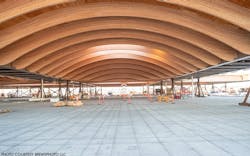Passengers traveling through the Portland International Airport (PDX) are in for a stunning surprise. The 81-year-old airport is currently undergoing a major transformation as part of the $2 billion PDX Next overhaul project. For the pièce de résistance, the main terminal building is getting equipped with a brand new, mass timber roof.
The $1.2 billion main terminal redevelopment has been in the works for the last 4 years as the Port of Portland has worked closely with local design firm ZGF Architects, and KPFF Consulting Engineers to develop and perfect their vision.
Aiming to incorporate more Pacific Northwest-inspired architecture that is both sustainable and earthquake resilient, designers looked to mass timber.
A Puzzle of Perplexing Proportions
The extensive 300,000-square-foot roof renovation features approximately 2.5 million board feet of timber. But the real star of the show is the nearly 300 magnificent 80-foot arched glulam beams from APA member Zip-O-Laminators.
The custom glulam beams feature various sized arches that will be intentionally placed to create a domed or vaulted effect in the ceiling.
The diaphragm is constructed from 2-inch mass plywood panels (MPP) from APA member Freres Lumber Co., which will be molded into place over the arched glulam. MPP is a large-scale, laminated-veneer-lumber-based engineered wood panel that can be used as alternative to cross-laminated timber (CLT).
Two local companies specializing in mass timber joined production to help bring the Port’s vision to life. “We’ve met every week for the last two-and-a-half years just going through the design and figuring out all details,” said Jared Revay, mass timber project manager at Swinerton Builders.
“The biggest challenge we’ve faced so far was with the design and fabrication and figuring out what the 2D shape of the MPP needed to be so that when you bend it, it fits precisely within the other pieces on the roof,” said Revay. “Every single piece on the roof is unique, with a unique number, that fits precisely within the contorting and bending of the roof. It’s critical all the joints align perfectly and that the panels are installed with great precision.”
The 2-inch-thick MPP is being molded into shape over the arched glulams manually, with exact fastening.
Timberlab, Swinerton Builders’ mass timber company, is serving as the fabrication partner on the project. “There are a number of MPP fabrications that are smaller, more unique and quite complex, and Timberlab is the only facility in the region that has the five-axis fabrication capabilities that can handle this volume,” said Revay.
The roof is being preassembled on-site in 18 massive cassettes that will be slid into place over the existing roof in a specific sequence. Revay expects each cassette sequence will take about one month for installation.
Construction on the main terminal roof is expected to finish fall of 2022, with the rest of the interior construction continuing through 2023. The final pieces of the PDX Next project are scheduled for completion in 2025.
Honoring a Heritage Deeply Ingrained
Wanting to honor and celebrate the local area, the Port prioritized sustainably and locally sourced timber for the project.
“The Port and the project stakeholders really wanted to support the local economy,” said Revay, explaining that all the timber used was sourced from within a 600-mile radius.
Oregon, the top producer of softwood lumber in the United States, has deep roots within the mass timber industry.
“MPP technology is relatively new and was developed by the Freres family who has been based in Oregon for nearly 100 years,” said Sam Dicke, business development representative with Timberlab. “Being able to use their product and support a great family-owned company is a really cool way to showcase that Oregon history.”
The complex and unique design proved to be challenging, but the team persisted fueled by a passion to create a beautiful, sustainable space that pays homage to the area’s rich history and creates a space to be enjoyed by travelers from around the world for years to come.
“Nearly 20 million people go through this airport a year. That’s about 50,000 people a day that will be seeing what’s possible with mass timber,” said Dicke. “That is the coolest thing in the world.”
Looking for more? Find additional case studies, design information and project inspiration at www.apawood.org.

